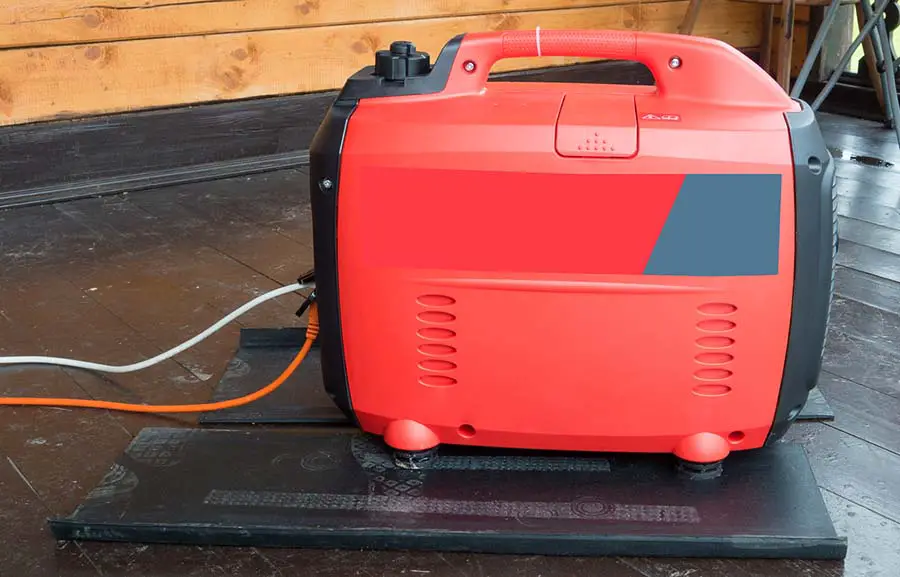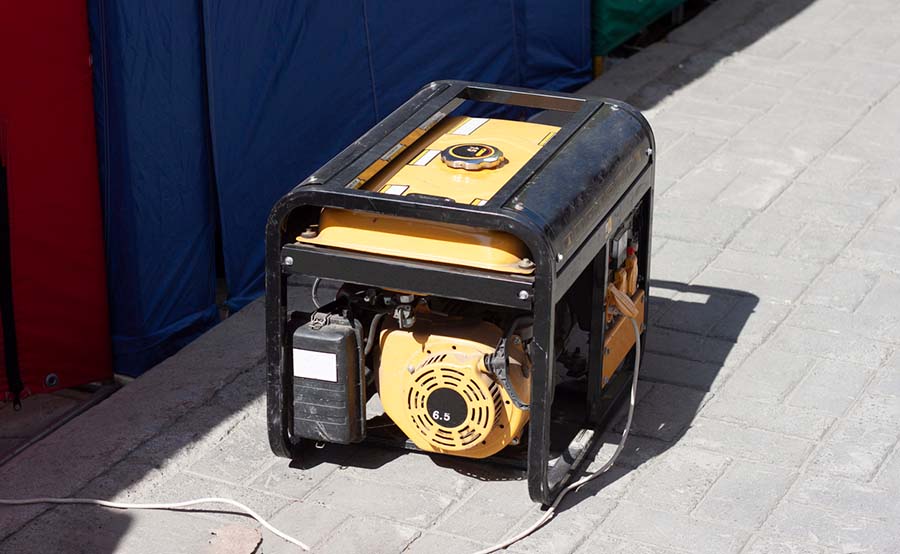
A portable generator is a powerful and valuable tool to have during a power outage. Due to the significant amount of carbon monoxide produced by portable generators, you must follow specific safety measures while in use.
Place portable generators at least 20 feet away from any window, door, or structure. The CDC recommends placing your generator at this distance and in the open air to avoid carbon monoxide poisoning. Keeping your generator at this distance also reduces fire hazards, electrical hazards, and noise.
Setting your portable generator the proper distance from your window is just one of many safety measures you take to ensure a safer emergency. Check out our tips to keep you safe until the power comes back on.
Why Does Your Generator Need to Be 20 Feet From a Window?
According to the Consumer Product Safety Commission, data shows that from 2005 to 2017, more than 900 people died of carbon monoxide poisoning due to misusing portable generators. Generators generally lack the elaborate exhaust control systems that an automobile has and therefore give off a significant amount of carbon monoxide that can quickly accumulate through a cracked window or door.
Injury or even death from carbon monoxide poisoning can occur within as little as five minutes when exposed to high levels. Even at 15 feet, a portable generator can cause a harmful build-up of carbon monoxide in a home or garage. The recommended distance for a generator is a minimum of 20 feet from your house or garage.
Researchers from the National Institute of Standards and Technology (NIST) performed a simulation to study generator emissions outside a single-story house. They noted how various factors could influence how much carbon monoxide finds its way inside a house. They tested placing the generator at multiple distances from the home and different wind and weather conditions.
They found that winds of lower speeds that blew perpendicular to the house were more likely to let carbon monoxide inside. These slower winds lingered longer around the windows and became part of the recirculated air going back into the house through the open window.
Where Do You Place a Portable Generator?

As mentioned above, your portable generator should be placed a minimum of 20 feet from your house, shop, or garage. You should always choose a place where the exhaust from the generator cannot enter your home or the home of any neighbors. This may mean assessing any prevailing winds that could blow the exhaust in an unwanted direction.
In addition, here are a few tips to keep in mind when selecting a place for your portable generator:
- Be careful not to place the unit in a location where children like to play and maybe left unsupervised. Educate your kids on the dangers of a generator and make sure they understand to keep their distance from the unit.
- Do not place your working generator inside an enclosed space or your house or garage. Even if the windows or doors (including a large garage door) are left open, it is not safe to have a generator inside.
- Your generator should never be placed next to any windows or doors or vents that lead into your house, shop, or garage. Even if they are closed, never put a generator near these openings.
- It is best practice to place your generator in an area free of too much moisture, dirt, and dust. Keeping your unit free of these things will ensure smoother and more efficient operation.To keep your portable generator as clean and dry as possible, you may wish to consider purchasing or building a pad for it to sit on.
- Building or buying an enclosure for your portable generator may also be a good idea for those with limited garage space. Some enclosures are meant for storage only. They are not usually vented enough to run the generator inside of them.
Precast concrete pads like the Generac Genpad can be purchased starting at around $299.00 and require minimal preparation for installation. These particular pre-made pads are available in 3-4 inch thickness and are about 54 inches long and 31 inches wide.
If you wish to build your concrete pad, the process is relatively simple for the average DIY’er. Here is a good video reference for the process.
Additional advantages of enclosures include protection from the elements, prevention of theft, improved yard aesthetics, and avoiding damage from wildlife.
If your enclosure is not meant to cover a generator while it’s in operation, you can use an open, canopy type cover while it is in use. This type of enclosure will allow lots of airflow around the generator and keep the unit from getting too wet.
Other enclosures are specifically designed to house the generator both while working and not working. These enclosures must be made of a fire-proof material and are well ventilated.
How to Avoid Carbon Monoxide Poisoning from a Portable Generator?
To avoid the dangers of carbon monoxide emissions from your generator, be sure that you have either a generator cord or an extension cord (rated for generator use) that will allow you to place the unit at least 20 feet from your house.
Placing your generator at least 20 feet away from your house in a spot with adequate ventilation and airflow is the best way to avoid any issues.
Additionally, you can install a carbon monoxide detector in your house. Make sure that you choose a battery-operated model so that it works during a power outage! These are useful to have in your home, even during non-emergency times.
What is Carbon Monoxide Poisoning?
Carbon monoxide is a colorless, odorless gas that can make a person very ill and even cause death. It is produced anywhere where there is combustion occurring.
If your generator is too close, you run the risk of having too much carbon monoxide accumulate in and around your home.
The symptoms of carbon monoxide poisoning can often be confused with other illnesses such as the flu. Symptoms include nausea, dizziness, headache, and tiredness.
If you or anyone else exposed to carbon monoxide experiences these symptoms, you should vacate the area immediately and seek medical attention.
What Other Hazards are Caused by Portable Generators?
In addition to the potential dangers of excessive carbon monoxide, portable generators can potentially pose other hazards as well.
Fuel Related Hazards of Portable Generators
Gasoline-powered generators can be dangerous if you do not appropriately handle them. Gasoline, as we know, is a highly combustible fuel that can explode and cause severe burns or even death.
When filling a gasoline-powered generator, ensure that the tank does not overflow. Any excess gasoline that overflows into the generator’s engine can cause a fire or explosion.
The fuel inside a fuel tank also expands, so best to leave space when filling the tank. You should always wait until the generator is off and completely cooled down before adding more fuel to the tank.
The generator’s surface can get very hot during use, so best not to touch the unit for any reason until it is thoroughly cooled and is safe to touch.
When storing your generator with gasoline in the tank, be sure that nothing nearby could cause a spark, such as an open flame, and ignite your generator. Do not allow anyone to smoke near the generator or any fuel.
Electrical Hazards Of Portable Generators
Portable generators can also pose potential threats, including electrical shocks and possible electrocution. There are a few things you can do to avoid these threats:
- Never overload your generator. Ensure that you know what the output rating is for your generator and do not exceed that limit. Never use more appliances than your unit can handle, and if need be, decide what appliances are most important to you and prioritize those. Overloading your generator can cause damage to the unit and also damage your household appliances.
- To avoid electrical issues, make sure to use the proper extension cords rated for heavy-duty, outdoor use. Power cords that are overloaded can cause fires, and you should never use cords that are damaged or have exposed wires.
- Unless you are a professional electrician, connecting your generator directly to your home’s wiring is a bad idea. Doing so can be very dangerous to your neighbors or utility workers as your generator can “feedback” onto the power lives servicing your house.
- Try to keep your generator as dry as possible by using an enclosure or a canopy-type covering. Avoid handling the generator while standing in water, and try to keep your hands as dry as possible when touching it.
- Be sure that your generator is properly grounded and inspect your unit on a regular basis. If something seems amiss, have the generator serviced by a professional.
- When you must move your generator or perform repairs, it is a good idea to disconnect the spark plug wire first. This hack will keep the generator from accidentally starting and causing harm.
How to Prevent the Theft of Your Portable Generator

Portable generators are expensive and valuable pieces of equipment. They are especially valuable and much desired in the aftermath of a natural disaster. Unfortunately, this means they are often the target of theft.
Portable generators are usually on wheels and easy for a thief to transport. They also hold their value, especially during an emergency, and are easy to sell for quick cash.
Fear of theft is one of the main reasons people keep their generators too close to their houses. They want to keep a close eye on their investment, and keeping it near a window is an excellent way to do this. Setting your portable generator near a window is, of course, a bad idea, so there are other anti-theft measures you can take:
- Securing your yard, in general, is an excellent first step. If you have a fence or gate, be sure to lock it. A security system is helpful if you can afford it, as are security cameras. Even if your camera is a fake, it may be enough to discourage a break-in.
- Don’t leave anything enticing laying around your yard, such as expensive kids’ bikes and if you have a dog (or even if you don’t), consider putting up a “beware of dog” sign or another indication that you have a dog around.
- The best way to prevent theft of your generator is to keep it in a designated enclosure. This helps to keep it out of sight and may make it easier to secure it with a lock.
- If you don’t have an enclosure for your generator, you can always chain and lock it to something nearby, perhaps a tree. Be sure to use a thick chain and a lock that isn’t easily cut with wire cutters. An excellent lock to try is a heavy-duty U-lock for bikes. Avoid using a light aluminum chain, as they are easy to cut through.
- To make your generator less portable and easy to steal, consider removing the wheels. This will make it much harder to remove the unit from your property.
- If a thief really wants to steal your generator, they will probably find a way. A lock and chain will definitely slow the process down for them, but if they get away with it, you can do a few things that might lead to you getting your generator back. Consider etching your name and pertinent information into the unit in large letters and in a conspicuous location. If the generator is sold to an innocent bystander, they may see the information and contact you.
Final Thoughts
Equipment placement is one of the most important things you must get right when operating a generator during an emergency or power outage.
Portable generators should never be used within 20 feet of your house and should never be placed near a window, door or vent.
You should always keep your generator well maintained and in a proper storage location when not in use. Keeping your unit on a concrete slab and in a designated enclosure 20 feet from your house is an excellent way to ensure that it continues to operate efficiently and safely.
If fear of theft motivates you to keep your generator close to your house, consider taking anti-theft measures to feel confident in placing your generator at a safe distance from your home.
